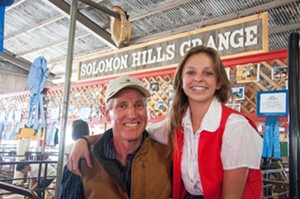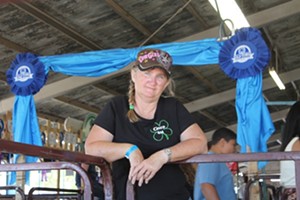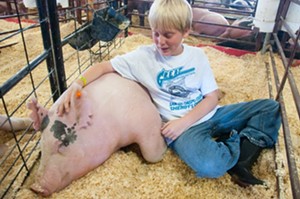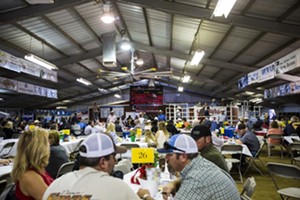
The sweet smell of hay mixes with the pungent, nose-wrinkling odor of manure and just a hint of old popcorn. If someone decided to bottle this scent as a perfume, it’d be called Eau de Fair.
It’s just after 8 a.m. on Saturday, July 12, at the Santa Maria Fairpark. The Santa Barbara County Fair doesn’t start for another three hours, but the auction barn on the southwest corner of the fairgrounds is already packed to the rafters with people.
The baritone buzz of the auctioneer’s voice is blaring out of numerous speakers positioned around the room. Old-time farmers and cowboys sit at plastic folding tables, poring over the auction list. Up for bid this morning is one of America’s favorite breakfast foods: bacon!
Well, not actual bacon, but rather the animal from which it comes: pigs.
When all is said and done, the 692 pigs registered at this year’s fair will have brought in thousands of dollars for their owners and the groups they belong to, but right now, everyone is focused on getting their oinkers ready for auction.
In the swine barn next door, children of all ages—some dressed in the iconic green-and-white attire of 4-H, others in blue or red vests representing FFA or the Grange—are busy caring for their animals. It’s an exciting and somewhat stressful day for everyone involved, especially for kids whose pigs decide to make a run for it on the way to the auction chute.
Amid the squealing bustle, 11-year-old Sam Bland of Solomon Hills Grange stands next to his pig, Fatty, scooping dirty shavings into a trashcan. He’s one of three Bland children registered in this year’s fair, along with his sisters Mackenzie, 15, and Whitney, 17. When the Sun approaches Sam, Mackenzie, and their dad, Greg, about posing for a photo with Whitney’s pig, Bailey, they’re game—until we ask Greg to get in the pen, too.
“They’re trying to get me in trouble,” Greg jokes with another dad.
It turns out parents of children competing at the fair aren’t allowed to get in the pigs’ pens, and they’re not allowed to feed or even touch the animals, unless they’re helping to move them to a new location. The kids are supposed to take complete responsibility for their swine.

Some parents break that rule, but Greg is a real stickler. In an interview with the Blands earlier in the week, he revealed that he and his brothers raised pigs when they were kids living in Atascadero.
“At one time, we had 10 sows and a couple of boars,” he said.
Now, just like his dad and grandfather taught him, Greg is teaching his children how to raise pigs as well.
“This is my fourth year doing it,” Mackenzie said. “I keep my pig at my house in my backyard [in Nipomo].”
Taking care of a pig is a part-time job for the teenager, in addition to school and volleyball practice. She said that during the summer she wakes up sometimes as early as 5 a.m. to feed and walk her pig, a routine she repeats in the evenings. Other chores include cleaning Bailey’s pen, bathing her, and weighing her once a week.
“And I also work with her a lot,” Mackenzie said, explaining that the more a pig’s owner works with it, the more likely it is to behave during the fair competition.
Prior to the fair, she helped Sam exercise his pig every day around lunchtime.
“He’s overweight,” she said of Fatty.
When asked what she likes most about being part of Solomon Hills Grange, she said, “I kind of really like everything about it. But I don’t like waking up early.”
What teenager does?
Passing it on
More information on Solomon Hills Grange No. 840 is available at facebook.com or californiagrange.org.
Orcutt resident Brittany Pollard has been raising pigs since she was 9 years old.
“Me and my cousin started showing large animals, and then my brother did, too,” she said. “We all took pigs because our moms did when they were our age.”
(Full disclosure: Pollard is the niece of the Sun’s sales manager, Kimberly Rosa.)
Even though Pollard has aged out of being able to show animals at the fair, the 20-year-old stays active in her husbandry group, Solomon Hills Grange No. 840, by serving as its turkey leader and helping out with the pigs.
Kids in Pollard’s Grange, including the Blands, show small animals, like rabbits and turkeys, and larger livestock, like pigs, heifers, and steers. They also compete in jackpotting and other competitions.
As the turkey leader and a pig helper, Pollard said she has to “be there whenever someone has trouble with their animals and guide them.”
When news started to come out about a new virus killing piglets in the Midwest and back East, Pollard started doing research on the sickness, called PEDv, so she could educate the kids and parents in her group.
“We started noticing [reports about] it at the beginning of this year,” she said, adding that officials in the industry advised families to buy their pigs in California from breeders whose farms weren’t infected with the virus.

“It mostly presents as diarrhea. They get really bad diarrhea, and it’s uncontrollable,” Pollard explained. “It’s affected almost 7 million piglets, most of which die because their bodies can’t handle it.”
If an adult pig gets sick, she said, “It just sets him back a bit.”
Most of the swine raised and sold on the Central Coast come from breeders in the Central Valley, though there are a couple of breeders in Arroyo Grande and farther south.
And while the virus has caused the price of pork to jump at grocery stores by as much as 10 percent, it hasn’t really affected prices at the fair because all of the pigs are bought by local families, businesses, farms, and even nonprofits.
A Santa Barbara-based nonprofit called the Wood-Claeyssens Foundation buys all of the large livestock at the fair that isn’t spoken for and donates it to the Santa Barbara County Foodbank. The foundation does the same thing at the fairs in San Luis Obispo and Ventura counties.
Building a tradition
When Trudy Shank’s kids told her they wanted to join 4-H, she thought her husband, Jon, would be the one to help them. However, it turned out that after years of raising animals, he’d had enough. So Trudy stepped in.
“I was raised in the military, so we didn’t have opportunities like 4-H,” she told the Sun in an interview at the fairgrounds. “My husband was in 4-H. He did it from the time he was 9 up into high school, but he wanted nothing to do with it. So I did it instead, and I’ve been in 4-H ever since.”
Like any devoted parent would do, Trudy immersed herself in animal husbandry, even though she didn’t know anything about livestock.
“We had rabbits as pets, but that’s about it. I had black labs,” she said.
So when her kids decided to raise pigs, she wasn’t sure what to do.

“I asked the pig leader, ‘How do you train a pig?’ And she knew I had a black lab and a Saint Bernard. She said, ‘Train them the same way you would a dog.’”
A few years later, Trudy took over as the group’s pig leader, a position she’s held for more than a decade. Her daughter Sheila, now 26, serves as the group’s community leader.
“I like helping the kids learn,” Trudy said. “The big thing [raising livestock] teaches is responsibility.”
She explained that prior to the fair, she tells the kids that taking care of their pigs and competing in the event is their job.
“I tell them that I am their boss, and they are my employees. They have to show up on time at 7 a.m. and again at 5 p.m. to feed the pigs. They have to do barn duty at least twice,” she said. “I have my kids work as a team because when they get into the workplace, they’re going to have to work together with other people. It’s not just about them; it’s about treating everyone with respect.”
The kids also have to follow a dress code.
“They have to wear pants and boots because I don’t want a pig to step on them,” she said. “They’re 250-pound pigs; they’re not the cute, little pigs we got at 46 pounds.”
Trudy explained that before the kids buy their pigs, she gives them a list of breeders and has them call the breeders to see how many pigs they have and what kinds.
“If they call in December or January and find out that all of the piglets died like with this virus, they have to find another breeder and find out if they have any babies that survived and where they are on the [wait] list,” she said.
Once they have their pigs, the kids learn how to care for them and how to train them. Trudy said that from the very beginning, she talks to the kids about the pigs to make sure they understand that they’re raising food, not pets.
They also have to learn about what kind of meat their buyers are looking for.

“The industry has changed a lot in the last few years,” Trudy explained. “Pigs today are shorter to the ground and rounder. In the show world, they were always long, tall, and skinny, but the processors in the market realized they were wasting too much money putting fat into the sausages.
“The buyers for the auction didn’t like that the meat was so dry and it tasted like sawdust, so they had to put a lot of fat in it to make it taste good,” she continued. “Now the meat is a lot juicier and more flavorful.”
She also teaches her kids the different cuts on a pig.
“I show them where the bacon comes from, where the chops, pork roast, and ribs come from,” she said. “We don’t lie to them. They’re not going to a farm.”
Trudy’s system, while strict, seems to work well for the children under her care.
The day the Sun visited with the group, kids of all ages were busy raking muck and sweeping shavings. When they weren’t working, they sat in groups talking and giggling at jokes.
One little boy came up to Trudy, who sat with the other adults in the shaded picnic area, to ask her a question.
“Miss Trudy, can I go get something to eat?” he asked.
“Yes, but then come right back,” Trudy replied.
After he left for the corn dog stand, Trudy said, “I let them run on Monday and Tuesday, but as soon as the fair gets started, I put the reins on.”
Contact Managing Editor Amy Asman at [email protected].










